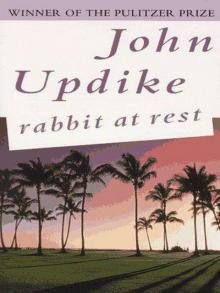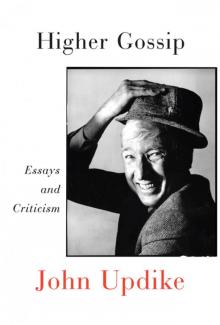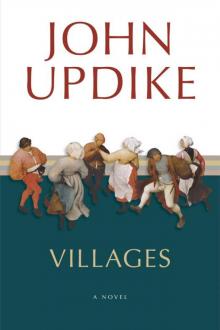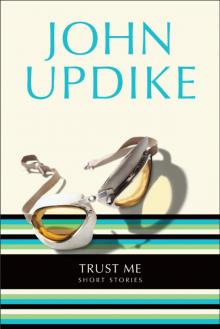- Home
- John Updike
Hub Fans Bid Kid Adieu: John Updike on Ted Williams
Hub Fans Bid Kid Adieu: John Updike on Ted Williams Read online
Also by John Updike
POEMS
The Carpentered Hen (1958) • Telephone Poles (1963) • Midpoint (1969) • Tossing and Turning (1977) • Facing Nature (1985) •Collected Poems (1953–1993) • Americana (2001) • Endpoint (2009)
NOVELS
The Poorhouse Fair (1959) • Rabbit, Run (1960) • The Centaur (1963) • Of the Farm(1965) • Couples (1968) • Rabbit Redux(1971) • A Month of Sundays (1975) • Marry Me (1976) • The Coup (1978) • Rabbit Is Rich(1981) • The Witches of Eastwick (1984) •Roger’s Version (1986) • S. (1988) • Rabbit at Rest (1990) • Memories of the Ford Administration (1992) • Brazil (1994) • In the Beauty of the Lilies (1996) • Toward the End of Time (1997) • Gertrude and Claudius (2000) • Seek My Face (2002) • Villages (2004) • Terrorist (2006) • The Widows of Eastwick (2008)
SHORT STORIES
The Same Door (1959) • Pigeon Feathers (1962) • Olinger Stories (a selection, 1964) •The Music School (1966) • Bech: A Book(1970) • Museums and Women (1972) •Problems and Other Stories (1979) • Too Far to Go (a selection, 1979) • Bech Is Back (1982) •Trust Me (1987) • The Afterlife (1994) • Bech at Bay (1998) • Licks of Love (2000) • The Complete Henry Bech (2001) • The Early Stories: 1953–1975 (2003) • My Father’s Tears (2009) • The Maples Stories (2009)
ESSAYS AND CRITICISM
Assorted Prose (1965) • Picked-Up Pieces (1975) • Hugging the Shore (1983) • Just Looking (1989) • Odd Jobs (1991) • Golf Dreams: Writings on Golf (1996) • More Matter (1999) • Still Looking (2005) • Due Considerations (2007)
PLAY
MEMOIRS
Buchanan Dying (1974)
Self-Consciousness (1989)
CHILDREN’S BOOKS
The Magic Flute (1962) • The Ring (1964) • A Child’s Calendar (1965) • Bottom’s Dream (1969) • A Helpful Alphabet of Friendly Objects (1996)
HUB FANS BID KID ADIEU
Hub Fans
Bid Kid
Adieu
John Updike on Ted Williams
THE LIBRARY OF AMERICA, a nonprofit publisher, is dedicated to publishing, and keeping in print, authoritative editions of America’s best and most significant writing. Each year the Library adds new volumes to its collection of essential works by America’s foremost novelists, poets, essayists, journalists, and statesmen.
If you would like to request a free catalog and find out more about The Library of America, please visitwww.loa.org/catalog or send us an e-mail [email protected] with your name and address. Include your e-mail address if you would like to receive our occasional newsletter with items of interest to readers of classic American literature and exclusive interviews with Library of America authors and editors (we will never share your e-mail address)
Published by The Library of America
14 East 60th Street, New York, NY 10021 All rights reserved. No part of this book may be reproduced commercially by offset lithograph or equivalent devices without the permission of the publisher.
www.loa.org
Copyright © 2010 by The Estate of John Updike
Copyright 1965, 1991, 2007 by John Updike
Published by arrangement with Alfred A. Knopf, an imprint of The Knopf Doubleday Publishing Group, a division of Random House, Inc.
Frontspiece: Ted Williams ascends to the Fenway field, September 28, 1960. Photograph by Dick Thompson, Courtesy The Sports Museum, Boston.
Endpapers: From the setting copy of “Hub Fans Bid Kid Adieu,” mailed by the author to The New Yorker on October 5, 1960. Courtesy Houghton Library, Harvard University, by permission of The Estate of John Updike.
Case: The Kid knocks another one out of Fenway Park: a moment from the mid-1940s. Photograph by Leslie Jones, courtesy The Boston Public Library Print Department.
Distributed to the trade by Penguin Group USA Inc., and elsewhere by Tlön, Buenos Aires, S.A., and in Canada by Penguin Group Canada Ltd.
Design by David Bullen Design
Library of Congress Control Number 2009934632
ISBN 978-1-59853-071-1
Manufactured in the United States of America
First Printing
ACKNOWLEDGEMENTS
“Hub Fans Bid Kid Adieu first appeared in The New Yorker, October 20, 1960, and was reprinted, with added footnotes, in Assorted Prose (1965). Parts of “Ted Williams, 1918—2002” first appeared in two essays, one in Sport, December 1986, the other in The New York Times Magazine, December 29, 2002; later versions were printed, respectively, in Odd Jobs (1991) and Due Considerations (2007).
Contents
Cover
Contents
Preface
Hub Fans Bid Kid Adieu
Ted Williams, 1918—2002
A Note About The Author
Praise For Hub Fans Bid Kid Adieu
Copyright and Acknowledgments
John Updike on Ted Williams, 1986 and 2002 Ted Williams as of 1986
Ted Williams
Contents
Preface
xi
Hub Fans Bid Kid Adieu
4
Ted Williams 1918—2002
40
Hub Fans
Bid Kid
Adieu
John Updike on Ted Williams
Preface
“Hub Fans Bid Kid Adieu” was a five days’ labor of love executed and published in October 1960. For many years, especially since moving to Greater Boston, I had been drawing sustenance of cheer from Williams’ presence on the horizon, and I went to his last game with the open heart of a fan. The events there compelled me to become a reporter. As I hurriedly composed this account, the facts were all in me, ready to be plucked, fifteen years’ accumulation. When I included the piece in a 1965 collection, Assorted Prose, I added, as footnotes, some additional information not then available to me. They stand as of 1965.
At the time of its magazine acceptance, the editor of The New Yorker, William Shawn, told me, graciously, that it was the best piece about baseball they had ever printed. This was a smaller compliment than it seems. For among Harold Ross’s many prejudices was one against baseball, and the magazine up to 1960 had contained few words on the subject. Thurber’s excellent baseball tall tale, “You Could Look It Up,” had been published elsewhere. Since the sixties, of course, Roger Angell has covered the beat more amply; inexhaustibly enraptured by the action on the field, omnisciently informed about our overexpanded leagues. Angell is a baseball freak where I was just a Williams freak. But I like to think I made The New Yorker safe for the Great American Game.
The piece was admired. The late George Frazier, who often put my name in his Boston Globe compilations of people who lacked Duende, identified it as the only decent thing I’d ever written. The compliment that meant most to me came from Williams himself, who through an agent invited me to write his biography. I declined the honor. I had said all I had to say, for that matter about every professional sport except golf. I did, however, write a mid-life sketch about Williams for Sport Magazine in 1986, and an obituary for The New York Times Magazine in 2002. They are abridged, conflated, and updated here under the heading “Ted Williams, 1918—2002.”
Romances sneak up on us. Once, at the age of twelve, on the awninged side porch of a pal’s house in Shillington, Pa., I found myself holding a board-game card marked “Williams.” Each card in the set had a punched-out center, around which was a circle divided proportionately to the named batter’s percentages (singles, doubles, walks, etc.). To play the game, as I remember, you fitted the card onto a spinner, flicked the arrow, and advanced a token base runner accordingly. My Schlagballbewu
ßtsein (see footnote 1, page 5) had not yet dawned; I had heard of DiMaggio, but not of Williams. Yet this strange bland name, not to be confused with Esther, was better; his arc of hits was immense. And he was mine. That day began the romance, the internalized ups and downs, whose last act was my attending a cloudy-day contest in late September, 1960, in Fenway Park.
J.U.
January 2009
HUB FANS BID KID ADIEU
FENWAY PARK, in Boston, is a lyric little bandbox of a ballpark. Everything is painted green and seems in curiously sharp focus, like the inside of an old-fashioned peeping-type Easter egg. It was built in 1912 and rebuilt in 1934, and offers, as do most Boston artifacts, a compromise between Man’s Euclidean determinations and Nature’s beguiling irregularities. Its right field is one of the deepest in the American League, while its left field is the shortest; the high left-field wall, three hundred and fifteen feet from home plate along the foul line, virtually thrusts its surface at right-handed hitters. On the afternoon of Wednesday, September 28th, 1960, as I took a seat behind third base, a uniformed groundkeeper was treading the top of this wall, picking batting-practice home runs out of the screen, like a mushroom gatherer seen in Words-worthian perspective on the verge of a cliff. The day was overcast, chill, and uninspirational. The Boston team was the worst in twenty-seven seasons. A jangling medley of incompetent youth and aging competence, the Red Sox were finishing in seventh place only because the Kansas City Athletics had locked them out of the cellar. They were scheduled to play the Baltimore Orioles, a much nimbler blend of May and December, who had been dumped from pennant contention a week before by the insatiable Yankees. I, and 10,453 others, had shown up primarily because this was the Red Sox’ last home game of the season, and therefore the last time in all eternity that their regular left fielder, known to the headlines as TED, KID, SPLINTER, THUMPER, TW, and, most cloyingly, MISTER WONDERFUL, would play in Boston. “WHAT WILL WE DO WITHOUT TED? HUB FANS ASK” ran the headline on a newspaper being read by a bulb-nosed cigar smoker a few rows away. Williams’ retirement had been announced, doubted (he had been threatening retirement for years), confirmed by Tom Yawkey, the Red Sox owner, and at last widely accepted as the sad but probable truth. He was forty-two and had redeemed his abysmal season of 1959 with a—considering his advanced age—fine one. He had been giving away his gloves and bats and had grudgingly consented to a sentimental ceremony today. This was not necessarily his last game; the Red Sox were scheduled to travel to New York and wind up the season with three games there.
I arrived early. The Orioles were hitting fungos on the field. The day before, they had spitefully smothered the Red Sox, 17–4, and neither their faces nor their drab gray visiting-team uniforms seemed very gracious. I wondered who had invited them to the party. Between our heads and the lowering clouds a frenzied organ was thundering through, with an appositeness perhaps accidental, “You maaaade me love you, I didn’t wanna do it, I didn’t wanna do it. . . .”
The affair between Boston and Ted Williams was no mere summer romance; it was a marriage, composed of spats, mutual disappointments, and, toward the end, a mellowing hoard of shared memories. It fell into three stages, which may be termed Youth, Maturity, and Age; or Thesis, Antithesis, and Synthesis; or Jason, Achilles, and Nestor.
First, there was the by now legendary epoch1 when the young bridegroom came out of the West and announced “All I want out of life is that when I walk down the street folks will say ‘There goes the greatest hitter who ever lived.’” The dowagers of local journalism attempted to give elementary deportment lessons to this child who spake as a god, and to their horror were themselves rebuked. Thus began the long exchange of backbiting, bat-flipping, booing, and spitting that has distinguished Williams’ public relations.2 The spitting incidents of 1957 and 1958 and the similar dockside courtesies that Williams has now and then extended to the grandstand should be judged against this background: the left-field stands at Fenway for twenty years have held a large number of customers who have bought their way in primarily for the privilege of showering abuse on Williams. Greatness necessarily attracts debunkers, but in Williams’ case the hostility has been systematic and unappeasable. His basic offense against the fans has been to wish that they weren’t there. Seeking a perfectionist’s vacuum, he has quixotically desired to sever the game from the ground of paid spectatorship and publicity that supports it. Hence his refusal to tip his cap3 to the crowd or turn the other cheek to newsmen. It has been a costly theory—it has probably cost him, among other evidences of good will, two Most Valuable Player awards, which are voted by reporters4—but he has held to it. While his critics, oral and literary, remained beyond the reach of his discipline, the opposing pitchers were accessible, and he spanked them to the tune of .406 in 1941.5 He slumped to .356 in 1942 and went off to war.
In 1946, Williams returned from three years as a Marine pilot to the second of his baseball avatars, that of Achilles, the hero of incomparable prowess and beauty who nevertheless was to be found sulking in his tent while the Trojans (mostly Yankees) fought through to the ships. Yawkey, a timber and mining maharajah, had surrounded his central jewel with many gems of slightly lesser water, such as Bobby Doerr, Dom DiMaggio, Rudy York, Birdie Tebbetts, and Johnny Pesky. Throughout the late forties, the Red Sox were the best paper team in baseball, yet they had little three-dimensional to show for it, and if this was a tragedy, Williams was Hamlet. A succinct review of the indictment—and a fair sample of appreciative sports-page prose—appeared the very day of Williams’ valedictory, in a column by Huck Finnegan in the Boston American(no sentimentalist, Huck):
Williams’ career, in contrast [to Babe Ruth’s], has been a series of failures except for his averages. He flopped in the only World Series he ever played in (1946) when he batted only .200. He flopped in the playoff game with Cleveland in 1948. He flopped in the final game of the 1949 season with the pennant hinging on the outcome (Yanks 5, Sox 3). He flopped in 1950 when he returned to the lineup after a two-month absence and ruined the morale of a club that seemed pennant-bound under Steve O’Neill. It has always been Williams’ records first, the team second, and the Sox non-winning record is proof enough of that.
There are answers to all this, of course. The fatal weakness of the great Sox slugging teams was not-quite-good-enough pitching rather than Williams’ failure to hit a home run every time he came to bat. Again, Williams’ depressing effect on his teammates has never been proved. Despite ample coaching to the contrary, most insisted that they liked him. He was generous with advice to any player who asked for it. In an increasingly combative baseball atmosphere, he continued to duck beanballs docilely. With umpires he was gracious to a fault. This courtesy itself annoyed his critics, whom there was no pleasing. And against the ten crucial games (the seven World Series games with the St. Louis Cardinals, the 1948 playoff with the Cleveland Indians, and the two-game series with the Yankees at the end of the 1949 season, winning either one of which would have given the Red Sox the pennant) that make up the Achilles’ heel of Williams’ record, a mass of statistics can be set showing that day in and day out he was no slouch in the clutch.6 The correspondence columns of the Boston papers now and then suffer a sharp flurry of arithmetic on this score; indeed, for Williams to have distributed all his hits so they did nobody else any good would constitute a feat of placement unparalleled in the annals of selfishness.
Whatever residue of truth remains of the Finnegan charge those of us who love Williams must transmute as best we can, in our own personal crucibles. My personal memories of Williams began when I was a boy in Pennsylvania, with two last-place teams in Philadelphia to keep me company. For me, “W’ms, lf” was a figment of the box scores who always seemed to be going three for five. He radiated, from afar, the hard blue glow of high purpose. I remember listening over the radio to the All-Star Game of 1946, in which Williams hit two singles and two home runs, the second one off a Rip Sewell “blooper” pitch; it was like hitting a balloon ou
t of the park. I remember watching one of his home runs from the bleachers of Shibe Park; it went over the first baseman’s head and rose methodically along a straight line and was still rising when it cleared the fence. The trajectory seemed qualitatively different from anything anyone else might hit. For me, Williams is the classic ballplayer of the game on a hot August weekday, before a small crowd, when the only thing at stake is the tissue-thin difference between a thing done well and a thing done ill. Baseball is a game of the long season, of relentless and gradual averaging-out. Irrelevance—since the reference point of most individual contests is remote and statistical—always threatens its interest, which can be maintained not by the occasional heroics that sportswriters feed upon but by players who always care; who care, that is to say, about themselves and their art. Insofar as the clutch hitter is not a sportswriter’s myth, he is a vulgarity, like a writer who writes only for money. It may be that, compared to such managers’ dreams as the manifestly classy Joe DiMaggio and the always-helpful Stan Musial, Williams was an icy star. But of all team sports, baseball, with its graceful intermittences of action, its immense and tranquil field sparsely settled with poised men in white, its dispassionate mathematics, seems to me best suited to accommodate, and be ornamented by, a loner. It is an essentially lonely game. No other player visible to my generation concentrated within himself so much of the sport’s poignance, so assiduously refined his natural skills, so constantly brought to the plate that intensity of competence that crowds the throat with joy.

 Picked-Up Pieces: Essays
Picked-Up Pieces: Essays Bech: A Book
Bech: A Book Roger's Version: A Novel
Roger's Version: A Novel Seek My Face
Seek My Face The Carpentered Hen
The Carpentered Hen Pigeon Feathers: And Other Stories
Pigeon Feathers: And Other Stories Rabbit Is Rich
Rabbit Is Rich The Afterlife: And Other Stories
The Afterlife: And Other Stories Rabbit at Rest
Rabbit at Rest The Witches of Eastwick
The Witches of Eastwick Gertrude and Claudius
Gertrude and Claudius Bech Is Back
Bech Is Back Hub Fans Bid Kid Adieu: John Updike on Ted Williams
Hub Fans Bid Kid Adieu: John Updike on Ted Williams Marry Me: A Romance
Marry Me: A Romance Museums and Women: And Other Stories
Museums and Women: And Other Stories My Father's Tears and Other Stories
My Father's Tears and Other Stories Collected Poems, 1953-1993
Collected Poems, 1953-1993 Trust Me: Short Stories
Trust Me: Short Stories Odd Jobs: Essays and Criticism
Odd Jobs: Essays and Criticism Rich in Russia
Rich in Russia Higher Gossip: Essays and Criticism
Higher Gossip: Essays and Criticism The Widows of Eastwick
The Widows of Eastwick In the Beauty of the Lilies
In the Beauty of the Lilies Rabbit, Run
Rabbit, Run The Early Stories: 1953-1975
The Early Stories: 1953-1975 Rabbit Redux
Rabbit Redux S.
S. Brazil
Brazil Toward the End of Time
Toward the End of Time The Centaur: A Novel
The Centaur: A Novel Assorted Prose
Assorted Prose Memories of the Ford Administration
Memories of the Ford Administration Terrorist
Terrorist Couples: A Novel
Couples: A Novel Bech at Bay
Bech at Bay The Music School: Short Stories
The Music School: Short Stories Villages
Villages S
S Roger's Version
Roger's Version Pigeon Feathers
Pigeon Feathers Higher Gossip
Higher Gossip Rabbit Redux r-2
Rabbit Redux r-2 Memories of the Ford Administration: A Novel
Memories of the Ford Administration: A Novel The Centaur
The Centaur Marry Me
Marry Me Picked-Up Pieces
Picked-Up Pieces Bech
Bech Rabbit Remembered
Rabbit Remembered Trust Me
Trust Me The Early Stories
The Early Stories Odd Jobs
Odd Jobs The Centaurus
The Centaurus The Afterlife
The Afterlife The Music School
The Music School Museums and Women
Museums and Women Couples
Couples